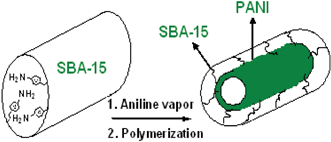In-situ polymerization of grafted aniline in the channels of mesoporous silica SBA-15†
Abstract
Monolayer N-propylaniline functionalized mesoporous silica SBA-15 (MFMS) has been successfully used for the grafting of polyaniline moieties through in-situ polymerization in the presence of ammonium peroxodisulfate (APS) as oxidant. For comparison, siliceous SBA-15 has been used to prepare non-grafted polyaniline (PANI) nanocomposites. The SBA-15, MFMS, and PANI nanocomposites were thoroughly characterized through powder XRD, TEM, SEM, FTIR, TG-DTA and N2 sorption measurements. The powder XRD pattern and TEM image of MFMS show a hexagonal (p6mm) structure. The FTIR, TG-DTA and N2 sorption studies confirm the presence of lattice bound N-propylaniline groups in MFMS material. The decrease in mesopore volume of MFMS from 0.89 to 0.61 ml g−1 after polymerization indicates that the polymers are well packed inside the channels of SBA-15. The thermal analysis further reveals that covalently grafted polyaniline decomposes at much higher temperature than the non-grafted analogue. The increased electrical conductivity of grafted polyaniline compared to non-grafted composites is attributed to the presence of more counter ions and the increased intensity of the “electronic-like absorption’ band at 1155 cm−1 of the former. The grafted PANI exhibits electrorheological effects with an increased shear viscosity under an applied electric field compared with the non-grafted polyaniline nanocomposite.


 Please wait while we load your content...
Please wait while we load your content...